Lost Incident Report Samples
-
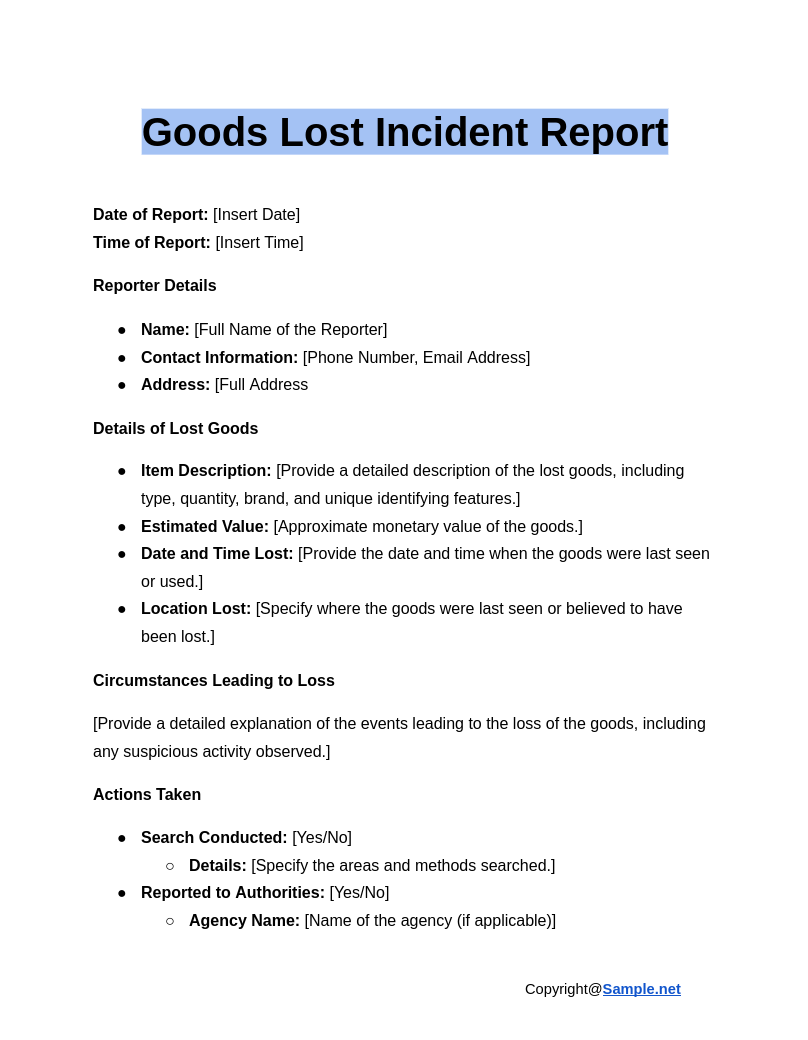
Goods Lost Incident Report
download now -
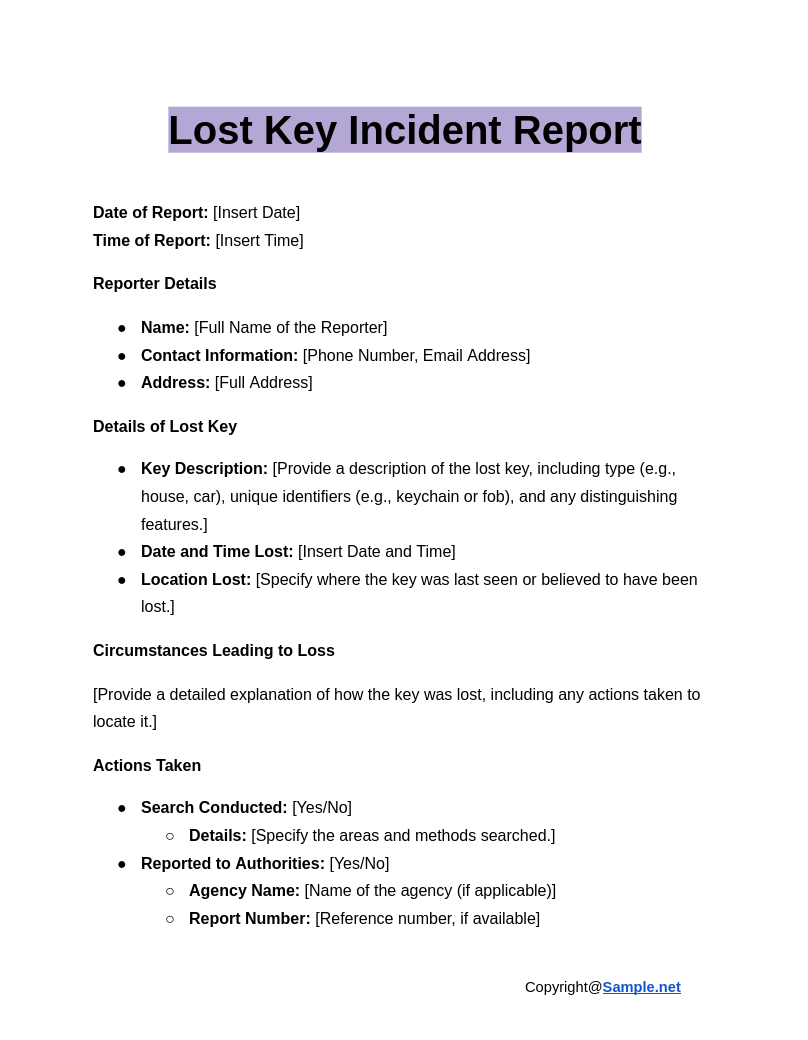
Lost Key Incident Report
download now -
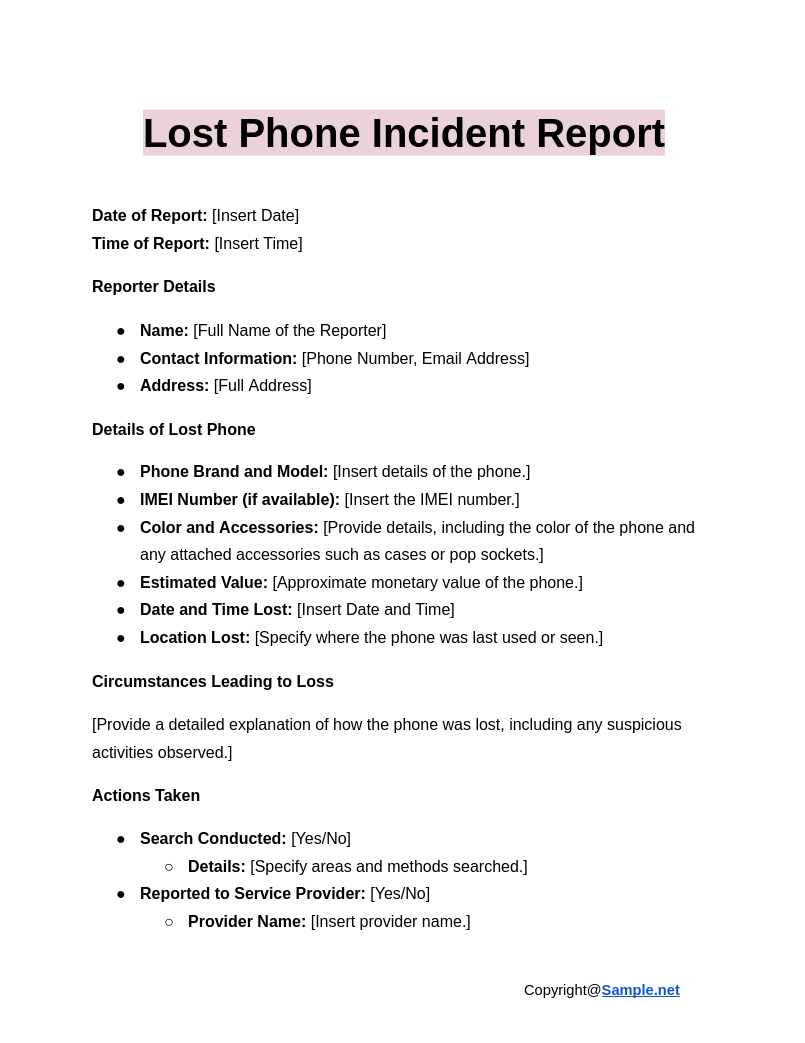
Lost Phone Incident Report
download now -
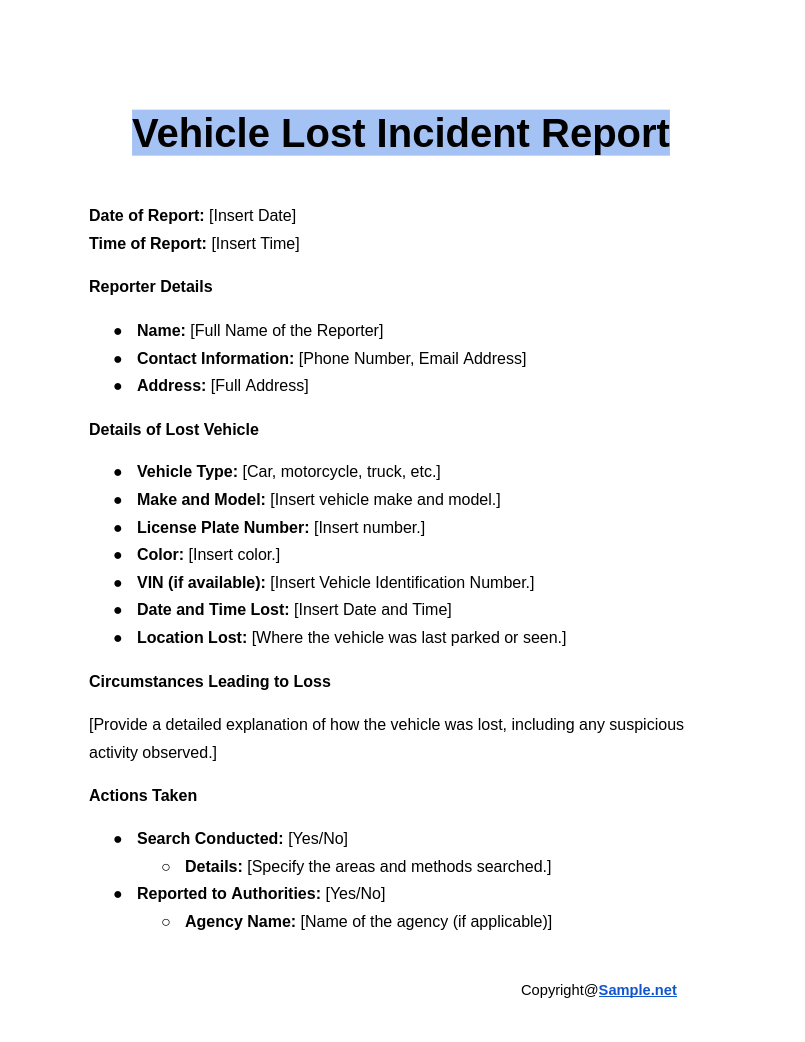
Vehicle Lost Incident Report
download now -
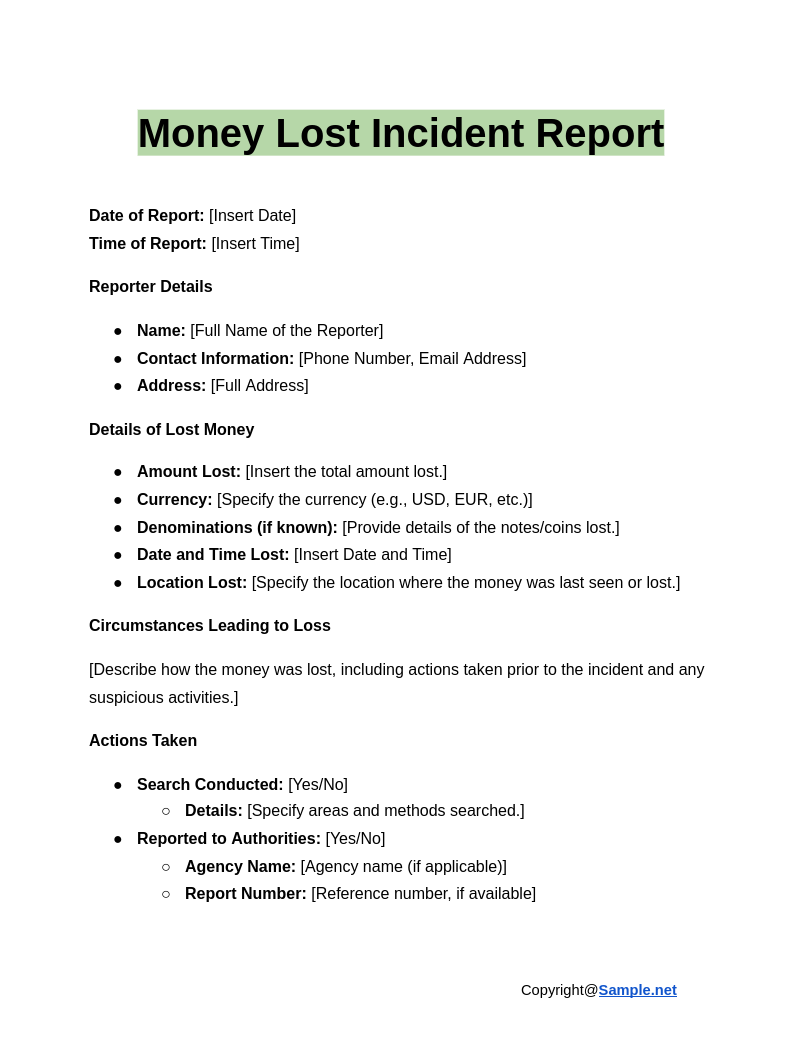
Money Lost Incident Report
download now -
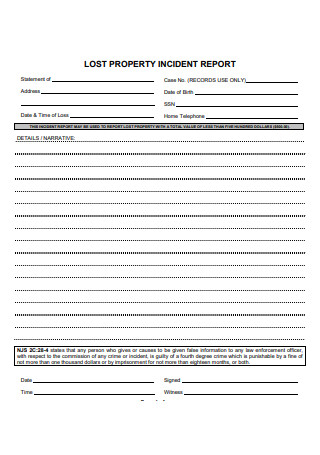
Lost Property Incident Report
download now -
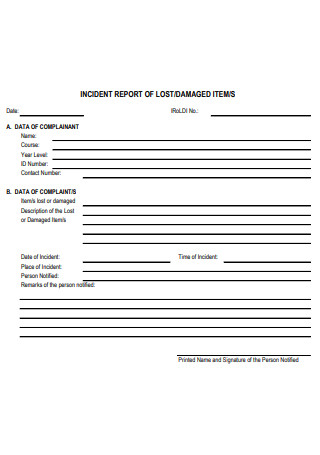
Formal Lost Incident Report
download now -
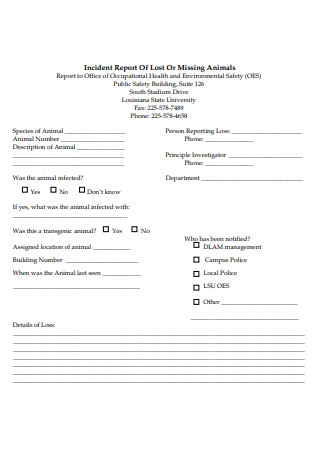
Lost or Missing Animals Incident Report
download now -
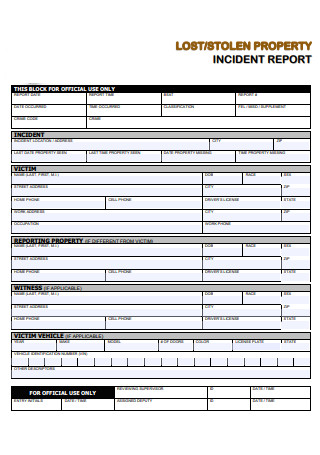
Lost Stolen Property Incident Report
download now
FREE Lost Incident Report s to Download
Lost Incident Report Format
Lost Incident Report Samples
What is Lost Incident Report?
Purposes of a Lost Incident Report
How to Create a Lost Incident Report
FAQs
Why are some incidents not reported?
How secure is the incident report for missing items?
What can be considered for a lost item incident report?
Can damaged items or theft be included in the lost incident report?
What are common mistakes to avoid when creating a Lost Incident Report?
What should organizations do after receiving a Lost Incident Report?
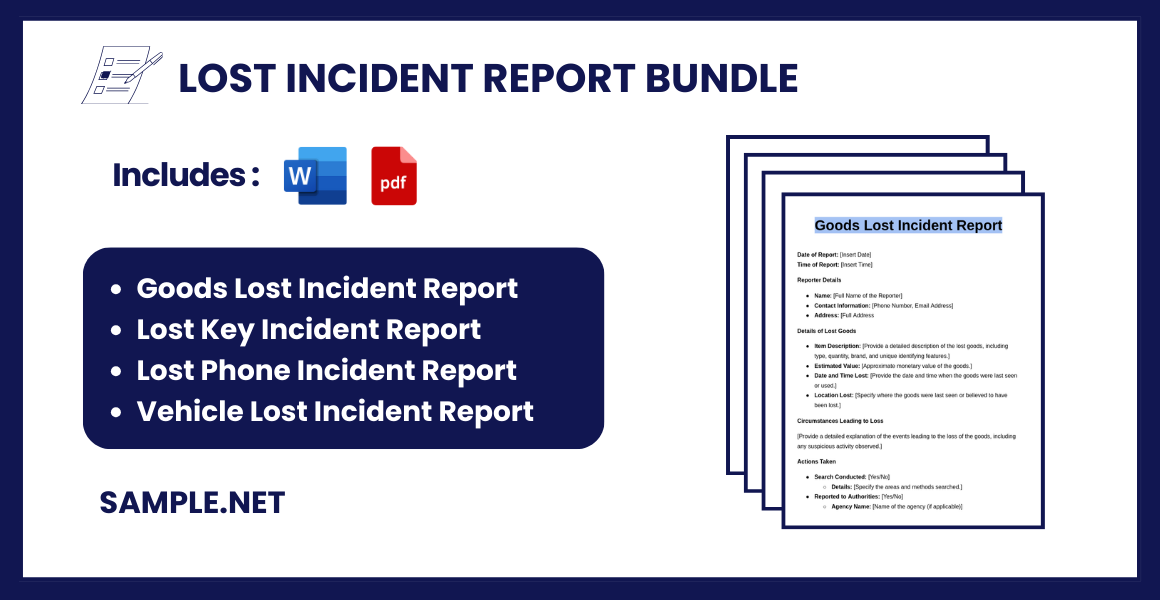
Download Lost Incident Report Bundle
Lost Incident Report Format
Date of Report: [Insert Date]
Time of Report: [Insert Time]
Reporter Details
- Name: [Full Name of the Reporter]
- Contact Information: [Phone Number, Email Address]
- Address: [Full Address]
Details of Lost Item
- Item Description: [Provide a detailed description of the lost item, including brand, color, model, size, and any unique identifying features.]
- Estimated Value: [Approximate monetary value of the item, if applicable.]
- Date and Time Lost: [Provide the date and time when the item was last seen or used.]
- Location Lost: [Specify where the item was last seen or believed to have been lost.]
Circumstances Leading to Loss
[Provide a detailed explanation of the events leading to the loss of the item. Include information on any actions taken to locate the item and whether any suspicious activity was observed.]
Actions Taken
- Search Conducted: [Yes/No]
- Details: [Provide information about areas searched and methods used to locate the item.]
- Reported to Authorities: [Yes/No]
- Agency Name: [Name of the agency (if applicable)]
- Report Number: [Reference number, if available]
Witness Information (if applicable)
- Name: [Full Name]
- Contact Information: [Phone Number, Email Address]
- Relationship to Incident: [Explain their involvement or observation of the incident.]
Attachments
[Attach photos, receipts, or other documents that can support the claim regarding the lost item.]
Declaration
I hereby declare that the information provided above is true and accurate to the best of my knowledge.
Signature: [Your Signature]
Date: [Insert Date]
What is Lost Incident Report?
A lost Incident Report is a formal record of the facts within the company or a workplace that may involve employees regarding a lost or stolen item of your possession. It can’t be helped that certain times you lose an item or two without your better knowledge. And filing a lost incident report is the best method to lay out facts and pieces of evidence without subjective wording in the way. If you have seen the various incident report format above, then you may have an idea of what the document looks like. But as a template, it only serves as a structure or base and you would still need to input your actual information in the report. Keep on reading to know how to write your own. You can also see more on Preliminary Incident Report.
Purposes of a Lost Incident Report
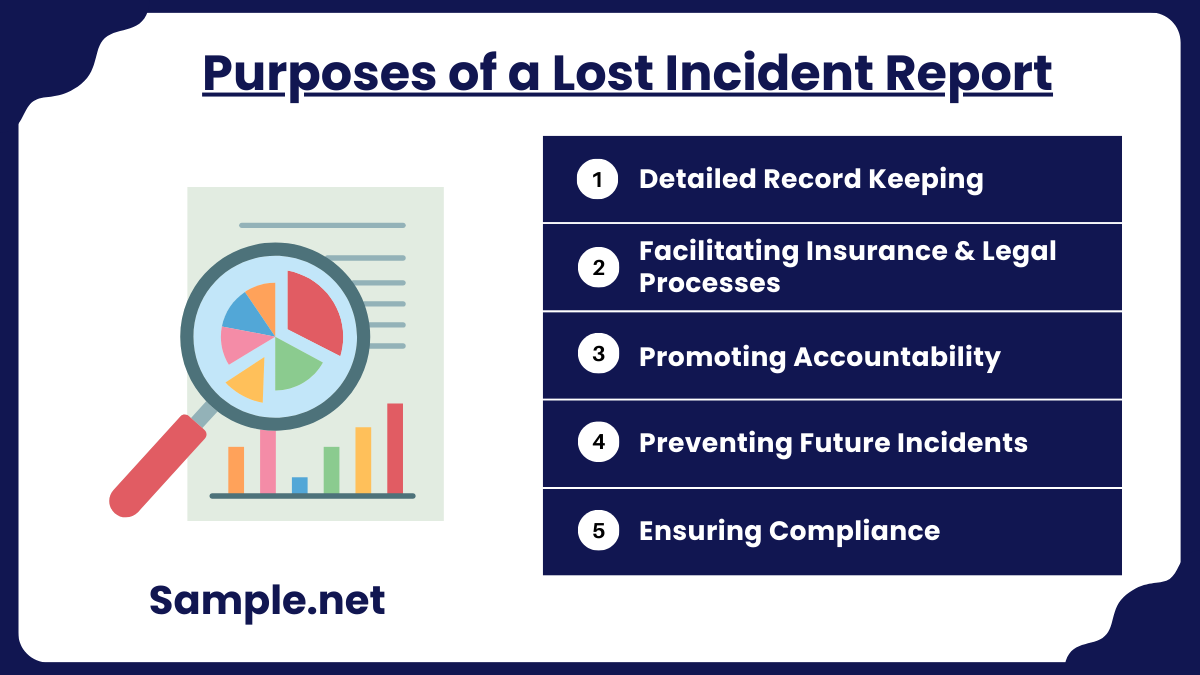
1. Detailed Record Keeping
A Lost Incident Report acts as a comprehensive log of incidents involving lost items or assets. It captures essential details such as the description of the item, the circumstances of the loss, the last-known location, and any initial actions taken. This meticulous record serves as an official document that can be referenced in the future to verify claims, track trends, or aid in recovery efforts. For organizations, it ensures consistency in handling loss-related situations.
2. Facilitating Insurance and Legal Processes
Lost Incident Reports are often indispensable in insurance claims and legal proceedings. Insurance providers typically require a well-documented report to process claims, as it establishes the legitimacy of the loss. Similarly, in legal disputes or audits, these reports provide a reliable account of the incident, reducing ambiguity and strengthening the case for compensation or resolution.
3. Promoting Organizational Accountability
For businesses and organizations, these reports foster a culture of accountability. By documenting who was responsible for the lost item and how the loss occurred, they create transparency and encourage adherence to protocols. This accountability helps organizations build trust among employees and stakeholders, as it demonstrates their commitment to responsibly managing resources. You can also see more on Audit Incident Reports.
4. Analyzing Patterns to Prevent Future Incidents
A well-maintained repository of Lost Incident Reports allows organizations to identify recurring patterns or vulnerabilities that lead to losses. For instance, frequent losses in a specific department might indicate a need for improved security measures or staff training. This proactive approach helps reduce future incidents, saving time, resources, and potential financial losses.
5. Ensuring Compliance with Regulations and Policies
Many industries and organizations operate under strict regulations requiring incident reporting. A Lost Incident Report ensures compliance with these rules by maintaining a standardized format for recording and handling such events. It also demonstrates due diligence in adhering to internal policies and external legal or regulatory obligations. You can also see more on Incident Violation Report.
How to Create a Lost Incident Report
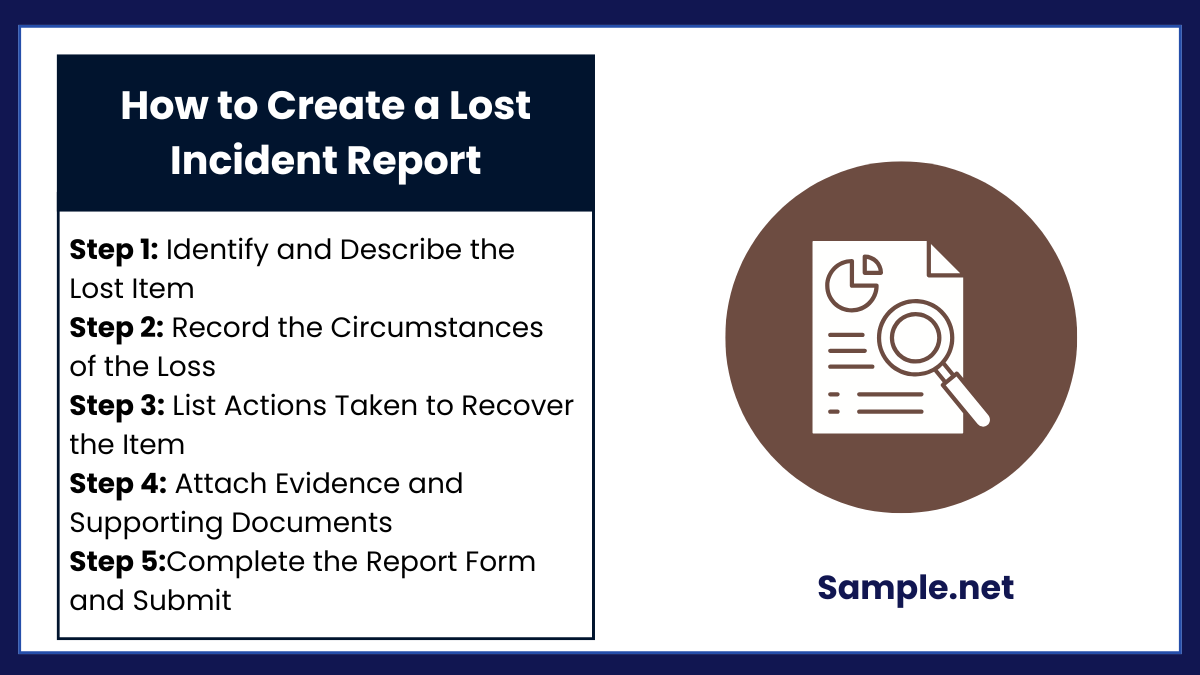
Creating a Lost Incident Report requires a structured approach to ensure all necessary details are captured accurately and the report is actionable. Here’s a step-by-step guide:
Step 1: Identify and Describe the Lost Item
Begin by clearly identifying the lost item. Provide specific details, such as the name of the item, its purpose, physical description, and any unique identifiers (e.g., serial numbers, tags, or markings). For example, if the lost item is a laptop, include its brand, model, color, and any distinguishing features. Accurate descriptions help authorities or relevant parties recognize the item if found. You can also see more on Hospital Incident Report.
Step 2: Record the Circumstances of the Loss
Document when, where, and how the loss occurred. Include details such as the date, time, and location where the item was last seen, along with any relevant circumstances leading up to its disappearance. For instance, if the item was lost during an office move, note the specific areas it was last used and transported to. Mention who was involved, if applicable, and any environmental factors like security breaches or accidents.
Step 3: List Actions Taken to Recover the Item
Outline the immediate steps taken after realizing the item was lost. For example, you might have retraced your steps, searched specific areas, or contacted colleagues to inquire about the item’s whereabouts. If any tools were used, such as reviewing security footage or using GPS tracking, include these details.
Step 4: Attach Evidence and Supporting Documents
Compile all available evidence to support the report. This might include photos of the item, purchase receipts, warranty papers, or screenshots (for digital losses). If there’s a timeline of events or maps of the location, attach those as well. You can also see more on Incident Analysis Reports.
Step 5: Complete the Report Form and Submit
Finally, use a predefined template or reporting system to document all the collected information. Double-check the report for accuracy and completeness before submitting it to the appropriate authority, such as HR, security, or insurance companies. If you’re submitting a digital report, ensure all attachments are properly uploaded. Retain a copy for your records.
FAQs
Why are some incidents not reported?
A worker may choose not to disclose an event in which they were engaged for a variety of reasons. All of them are comprehensible, but once we comprehend why the report was needed, we should see that none of them are acceptable. Fear of management retaliation, a desire not to have the event on their work records, a desire not to lose time from their job assignment, a desire not to jeopardize the department’s safety record, and a desire not to be the focus of an incident inquiry are all genuine reasons. You can also see more on School Incident Report.
How secure is the incident report for missing items?
As any legal documents are treated, the authorities or employees receiving your report with information that can be considered classified will be handled with the utmost confidentiality. Trust that it will be safe and they will not in any means toy with the information that you have placed in the report. If there is tampering or unauthorized use of the information you have jotted down, then you are able to write another complaint about such mishandle to the police through a Police Report.
What can be considered for a lost item incident report?
Any item that is associated with you and granted to you for use by either the company or a larger corporation can be considered to be reported. Regardless of size but if the value is considerably greater such as a missing identification card, then you are encouraged to write a lost id incident report. Then again, evaluate the situation of how grave the loss of the item is and how it affects the flow of your work. Any item within considerable bounds should be reported and not exaggerated in the report.
Can damaged items or theft be included in the lost incident report?
Items are important to anyone much more with the added sentimental value of it, so there are chances that people who are eyeing it did not keep their hands to themselves and took the item before anyone could notice. If such thievery was done within the company grounds, then you are able to include it in the lost incident report. But do remember to not let your anger or suspicions get to you. Try to be as calm and collected when writing the report and don’t blamelessly accuse anyone in your proximity of taking the lost or broken item. Not only will this make you look bad but also cause gossip between your coworkers. You can also see more on Product Incident Report.
What are common mistakes to avoid when creating a Lost Incident Report?
Common mistakes include omitting critical details, providing inaccurate information, failing to attach supporting documents, or not submitting the report promptly. These errors can hinder recovery efforts or delay claims processes.
What should organizations do after receiving a Lost Incident Report?
Organizations should verify the report, investigate the incident, take corrective measures to prevent future losses, and communicate progress with the individual who submitted the report. You can also see more on Laboratory Incident Report.
